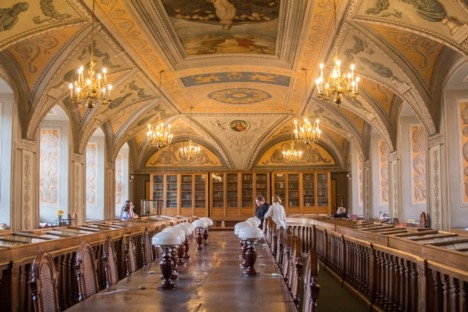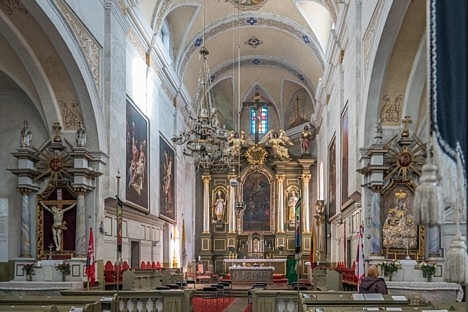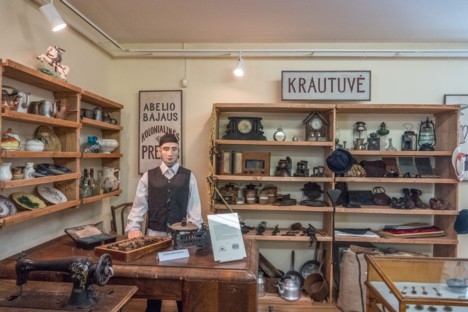Lithuania is an amazing country whose existence is marked by unique cultural and valuable objects. Some receive more attention, others less, but the fact is that each one is exceptional and tells its story through architecture, decorative elements and its purpose.
By visiting the cultural objects and specific places discussed below, you will not only get to know Lithuania better, but you may also discover a part of yourself in it. After all, the peoples of this continent for centuries copied and studied each other and shared their experiences. It is not for nothing that quite a few architectural structures of Lithuania reflect Italian, French and other nations, the beauty of which is most easily noticed by the inhabitants of that country.
Reklāma
Lithuanian cultural artifacts that create history
Old Trakai is one of the most remarkable towns that reminds us of the greatness of Lithuanian history and nowadays invites tourists to get acquainted with the history of the Grand Duchy of Lithuania (GDL) which touches every Lithuanian. It is not for nothing that the Old Trakai is called the pearl of the inheritance of the Lithuanian capital lands. Its history includes the life of the Karaites in our lands. However, most often it is mentioned because of the honorable life of the Grand Duke of Lithuania Vytautas in this region. This outstanding personality, the ruler of our nation to this day, is mentioned as one of the most significant people not only in the history of the GDL, but also in the history of the whole Lithuania as a nation. Sources indicate that Vytautas the Great died in the Old Trakai Castle at the honorable age of 80. In the Middle Ages, reaching that age was indeed unusual, so it is not for nothing that there are legends about Vytautas' magical powers or even powder that helped him to live so long. Speaking of the Middle Ages in Lithuania, the impressive Kaunas Castle, which has been mentioned in historical sources since 1361, attracted a lot of attention. It has to this day withstood wars, fires, occupiers and was continuously being restored for another life and is currently accessible for every tourist.
The notable manor of Užutrakis boasts interesting history and is currently a place of cultural events, which invites not only Lithuanian citizens but also visitors of our country to get acquainted with ancient Lithuania and the cultural heritage of Tiškevičiai. The magnificent manor with French parterres (which are worth seeing at all times of the year) is surrounded by English gardens fragrant with luxury and elegance. And although it is nice to just take a walk in this park, be sure to come for the events that take place at a more or less similar time every year. Visitors must not forget the Plungė Manor which hosts Mykolas Oginskis international music festival in September. This is one of the best preserved complexes which was built in the19th century. The magnificent park, whose construction began in the 18th century, was dedicated to pagan rituals that were still quite popular in isolated places in that century.
Get to know the country's legendary artifacts. Sources reveal that in the 10th century a small wooden castle stood on the Aukštadvaris mound. It was demolished in the 14th century. Unfortunately, at the moment there are no remains left. Still, archaeologists are pleased to find objects which are related to local and everyday life – from axes to dishes. The wonderful lake Pilaitė opens up from the top of the mound. It is said to contain the treasure of the princess, which got here with the noble girl and her puppy when her horses took fright. Whether it is true or not, it is up to you to believe it or not. But the view from the mound is really wonderful.
Of course, a noteworthy treasure of Lithuania is Vilnius University. It is an amazing architectural structure, which is valued not only for its design, but also for the unique personalities who “grew up” in it. Nowadays, it is often presented as one of the most important symbols of the country. It was founded in 1579 by the Jesuits. The privilege to establish it was granted by Stephen Bathory, so it was not for nothing that during the revival of the University it was partially called by the name of this person. The Vilnius observatory, not only in the capital, but also throughout Lithuania, often receives too little attention. And it should definitely be paid, because the unique-looking Baroque building is built on the three-story northern side of the campus. We can be proud that it is the oldest observatory in Eastern Europe and the fourth oldest in the whole world!
The Radvilas Palace in Vilnius, where the nobles of one of Lithuania's most famous families lived, is also eye-catching. Leaving behind a huge cultural heritage, they encouraged people, especially the poor ones, to read more, to become more culturally active, even to take an interest in the history of the country. The Raudondvaris Manor in Kaunas district must also be included in the list of gorgeous architectural objects. It is a magnificent monument of the Renaissance of the 17th century in our country. Not only the manor but the park surrounding it and other farm buildings is amazing.
Čiurlionis House in the Old Town of Vilnius is the residence of this country's genius, where he created both music and paintings. Here you will find not only the everyday items of the artist but also the Bechstein piano. If you are interested in high-quality reproductions of the artist's musical legacy you can purchase them at the artist's house. National M. K. Čiurlionis Art Museum is located in Kaunas. Many want not only to see his works, but to hear the stories from the guides about the wonderful passion of love between this artist and Sofia.

Finally, the 16th century Chodkevičiai Palace, which perfectly reflects the style of late classicism, is also worth noting in our country. Generations of Chodkevičiai lived here for more than three centuries. Later it was transferred to Vilnius University. The building was used to accommodate scientists, artists, poets. Currently, the palace has a Vilnius picture gallery, where you can see the works of not only famous artists, but also artists and sculptors who are just on the rise.
Religious buildings – the culture of our country
Even those who are not interested in religion should visit as many Lithuanian churches, cathedrals, holy places as possible, as they perfectly convey not only the faith, but also the culture of the country and the awareness of people in different times of our country. For example, an amazing building in Kaunas district is the ensemble of the Pažaislis Camaldolese Monastery, which is often associated with mystery and mysticism. Pažaislis Camaldolese Monastery was the very first building built by the Order in the Grand Duchy of Lithuania, designed even by artists from Italy: architect Giovanni Batista Fredianis, painter Mykolas Angelas Palonis, sculptors Giovanni Merlis and Mikalojus Volšeidas, painter Giuseppe Rosis and others. No less noteworthy is Kaunas Christ's Resurrection Basilica which opens the panorama of the city from the observation deck. This church is the largest basilica-type church in the Baltics, so you will see how unique it is from far away. It is also worth visiting because of the nearby funicular built in 1931. The complex of buildings of Kaunas Holy Trinity Church, Bernardine Monastery and Priests Seminary, located throughout the Town Hall Square in Kaunas, is also eye-catching. Next to it is the Town Hall, the symbol of the city, which currently houses a museum. Not far from it is Kaunas State Musical Theater, a unique object of the city built in the 19th century.

Speaking of religious objects in Lithuania, one must also keep in mind the complex of the Church of the Crucified Jesus in Panevėžiukas, which is the only such object in Lithuania. Although religion is important to many, the majority of people visit the church because of its unique architecture. This triangular-shaped church of basic and cold baroque interior perfectly incorporates elements of folk art. The Church of St. Peter and St. Paul in Varniai is also wonderful. The famous teetotaler of the country Motiejus Valančius, whose cultural contribution is important not only for Varniai, but also for the whole of Lithuania, studied and worked in this city.
Lithuanians know that the Samogitian Calvary is one of the most sacred places in the country. However, most often, those who are not religious speak of its mysticism because of the good aura around the church. The shrine is also attractive because of the Way of the Cross that the believers follow every year. The pilgrimage route includes 19 stations of the Way of the Cross and stretches for 7 kilometers. The Samogitian Calvary also houses the museum of the famous poet Vytautas Mačernis. Finally, one of the oldest churches in Lithuania is the Church of St. Peter and St. Paul in Plateliai. Although only 1,000 inhabitants live in Plateliai, it is amazing that the church is very luxurious, even magnificent. Not every major city in Lithuania can be proud of this.
Lithuania's uniqueness lies in art, people and cultural heritage sites
It is really quite difficult to classify places of interest in Lithuania. There are a lot of them and each one is different. Of course, the more of them you visit, the better you will get to know the country which gives meaning to the Baltic, Scandinavian and Eastern European nations. A noteworthy symbol of the 18th-19th centuries is the homestead of Biržuvėnai manor. It illustrates very well the architecture of that time and that period of time. It is worth visiting the manor, because of the very well preserved parts of the buildings of that time: a farm building, an industrial building, residential area and a representative space for receiving guests. Compared to other mansions, this one may look quite minimal in appearance, but it perfectly reflects the life of the locals 200 years ago.

The Samogitian Museum “Alka” is the pride of the locals, where a lot of heritage is specifically dedicated to the manor culture in Lithuania. For those who want to see what the lives of peasants entailed, it is worth visiting the Samogitian Village Museum. Those interested in the history of more recent times must definitely visit the Rainiai memorial site. The Rainiai tragedy of June 22-28, 1941, was the result of retreating Soviet soldiers who killed 75 political prisoners in Telšiai prison: teachers, students, farmers, craftsmen, and finally workers who had been convicted for their political views. As for the 20th century and its tragedies, it is necessary to visit the Kaunas Ninth Fort Museum and a memorial dedicated to the memory of the Nazi victims.
And of course the wonderful Plateliai, loved by both Lithuanians and visitors of the country. The beginning of the Plateliai Manor Homestead dates back to the 17th century. The foundations of the manor were formed at the end of the 17th-18th century. Many are surprised to learn that, until the 1940s, Plateliai belonged to the family of Count de Choiseul Gouffier of France. Then the question arises: perhaps the town has a legacy of the maneuverable French life? The Plungė manor homestead is often associated not with architecture, but with the famous Lithuanian artist Čiurlionis, whose museum, as we have already mentioned, can be found in Kaunas. If you want to get to know the nature of Lithuania better, you should visit the Babtynas mound in Piepaliai which opens up a beautiful panorama. This mound reminds us of the pagan legacy which is very dear to many Lithuanians.
And this is Lithuania. Diverse, multi-layered, growing with each new architectural find. Get to know it.
Project no. 05.4.1-LVPA-K-808-02-0022 “Application of tourism e-marketing tools” is implemented in accordance with the 2014-2020. Measure of the European Union Funds Investment Operational Program “E-Marketing of Priority Tourism Development Regions”.

More information about the places to visit in Lithuania could be found



